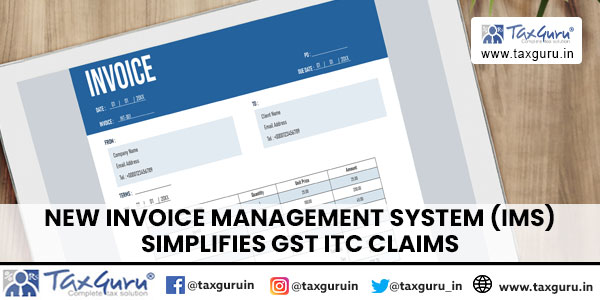Introduction
Mismatches between invoices filed by suppliers and returns submitted by recipients are significant issue taxpayer’s face when claiming input tax credits. A new system has been introduced on the GST portal to help taxpayers easily correct or amend invoices with their suppliers. This will make it easier for them to match their records with the invoices issued by their suppliers and claim the correct Input Tax Credit (ITC). This functionality is known as Invoice Management System (IMS) which will allow the recipient to either accept or reject an invoice or to keep it pending in the system, which can be availed later.
IMS was developed by GST Council and GSTN (Goods and Services Network) and it was launched on 1st October 2024, made available to users on 14th October for ITC computation and claim process.
The said functionality would be a major enhancement in the ITC ecosystem of GST. Now, only the accepted invoices by the recipients would become part of their GSTR-2B as their eligible ITC. Therefore IMS will provide the taxpayers an opportunity to review the genuineness and authenticity of the received invoices. Once the suppliers save any invoice in GSTR 1/IFF/1A/the same invoice would be reflected in the IMS dashboard of the recipient.

Flow of IMS under GST
- When supplier files GSTR1/IFF/1A on GST Portal, The records will automatically appear in the recipient’s IMS dashboard and eventually in GSTR-2B.
- Recipients can accept, reject, or leave invoices pending. These actions can be taken from the time of saving the records in GSTR 1/ IFF/1A by the supplier taxpayer till the recipient taxpayer files his/her corresponding GSTR-3B. If recipient doesn’t take any action on an invoice in IMS then it will be deemed accepted and will move to GSTR-2B as an accepted invoice.
- Pending records can be accessed in the future. (Example: A supplier issues an invoice for Rs 50,000/-, but the recipient identifies a discrepancy and claims the correct value should be Rs 45,000/-. The invoice is marked as “Pending” until the issue is resolved.
- Once accepted in the IMS, an invoice will become a part of GSTR-2B. The portal will auto-populate GSTR-2B and GSTR-3B with tax-paid details from the accepted invoice for the ITC claim.
- Once rejected in the IMS, an invoice will not become part of the GSTR-2B, and the portal will not auto-populate GSTR-3B with details of the rejected invoice.
- IMS at the supplier’s end will show rejected invoices and allow the supplier to amend invoices through GSTR-1 (if not filed already) or GSTR-1A.
- When GSTR-3B is filed for a period, all the accepted/rejected records except records with PENDING status until the limit as per u/s 16(4) of CGST Act (i.e. after the due date for filing the return for 30th November of the next financial year, or the actual date of filing the annual return for that year related to that period, whichever is earlier) will be removed from IMS.
Steps to access IMS in GST Portal:
1. Login to GST Portal by using respective GST ID and Password.
2. Access IMS following the following path:
GST Portal dashboard > Services > Returns > Invoice Management System (IMS) Dashboard.
Records which will be available in IMS for taking action:
The IMS dashboard will make available the following records related to the invoices saved or filed by the suppliers through GSTR-1/1A/IFF.
> B2B – Invoices
> B2B – Invoices (Amendments)
> B2B – Debit Notes
> B2B – Debit Notes (Amendments)
> B2B – Credit Notes
> B2B – Credit Notes (Amendments)
> Eco [9(5)] Invoices
> Eco [9(5)] Invoices (Amendments)
Who need to compliance IMS?
Compliance of IMS (Invoice Managing System) primarily applies to taxpayers who are eligible to claim Input Tax Credit (ITC) and are filing returns that require reconciliation of purchase and sales invoices.
Benefits of IMS in GST
The Invoice Managing System (IMS) in GST offers several benefits to businesses, the tax system, and the government by ensuring better transparency, accuracy, and compliance. Here are the main advantages of IMS under the Goods and Services Tax regime:
1. Accurate Input Tax Credit (ITC) Claims:
IMS ensures that businesses can claim ITC only on legitimate purchases where the supplier has correctly uploaded their invoices. This prevents fraud and ensures businesses only claim credits for goods and services they’ve actually received.
2. Better Control for Tax Authorities:
- IMS helps tax authorities in monitoring businesses and verifying the accuracy of their claims.
- It improves the detection of fraudulent activities and ensures that businesses are paying the correct amount of tax.
- The system provides real-time access to invoice data, making it easier for tax officers to track compliance.
3. Reduction in Tax Evasion:
- By matching sales and purchase invoices between buyers and sellers, IMS significantly reduces the possibility of tax evasion. Suppliers cannot issue fake invoices because the buyers can easily cross-check the data in the system.
- It prevents suppliers from collecting GST from buyers but failing to remit the collected GST to the government.
4. Available for QRMP taxpayer
The new invoice management system will be helpful for small businesses and is also available for QRMP taxpayers. However, it will not automatically populate GSTR-2B for the first two months of a quarter. Instead, for QRMP taxpayers, GSTR-2B will be generated on a quarterly basis.
Conclusion-:
The introduction of the Invoice Management System (IMS) under GST marks a significant step toward enhancing transparency, efficiency, and compliance in the ITC claim process. By automating invoice reconciliation and allowing real-time tracking of transactions, IMS ensures businesses claim Input Tax Credit accurately while reducing the risks of tax fraud and evasion. With seamless integration into the GST portal, taxpayers can efficiently manage their invoices, accept or reject claims, and maintain compliance without unnecessary complexities. Furthermore, the system empowers tax authorities with better oversight, promoting a fair and accountable taxation framework. Overall, IMS simplifies the GST ecosystem, fostering trust between businesses and the government while streamlining tax administration for long-term economic growth.





